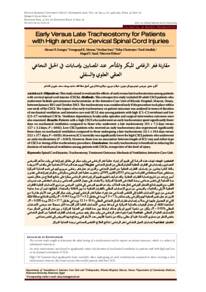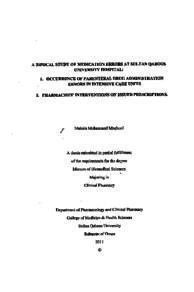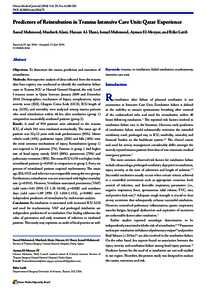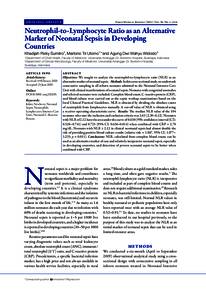Document
Early versus late tracheostomy for patients with high and low cervical spinal cord Injuries.
Identifier
doi: 10.18295/squmj.2016.16.04.009
Contributors
Menon, Venugopal K., Author
Suri, Neelam., Author
Chatterjee, Nilay., Author
Attallah, Emil., Author
Saad, Maged Y., Author
Elshaer, Shereen., Author
Other titles
مقارنة فغر الرغامى المبكر والمتأخر عند المصابين بإصابات في الحبل النخاعي العنقي العلوي والسفلي.
Publisher
College of Medicine, Sultan Qaboos University.
Gregorian
2016-11
Language
English
Subject
English abstract
This study aimed to evaluate the effects of early versus late tracheostomies among patients
with cervical spinal cord injuries (CSCIs). Methods: This retrospective study included 69 adult CSCI patients who
underwent bedside percutaneous tracheostomies at the Intensive Care Unit of Khoula Hospital, Muscat, Oman,
between January 2011 and October 2015. The tracheostomy was considered early if the procedure took place within
one week of the CSCI. The impact of an early tracheostomy on patient outcomes was analysed in terms of duration
of mechanical ventilation and intensive care unit (ICU) stay among patients with high (C1–C2 vertebrae) and low
(C3–C7 vertebrae) CSCIs. Ventilator dependence, bradycardia episodes and surgical intervention outcomes were
also examined. Results: Patients with a high CSCI who underwent an early tracheostomy spent significantly fewer
days on mechanical ventilation compared to those who underwent a late tracheostomy (9.3 ± 7.2 days versus
13.7 ± 3.2 days; P = 0.041). Low CSCI patients who received an early tracheostomy also experienced significantly
fewer days on mechanical ventilation compared to those undergoing a late tracheostomy (12.1 ± 10.4 days versus
25.2 ± 17.7 days; P = 0.035). Moreover, ICU mortality was significantly lower for high CSCI patients who underwent
an early tracheostomy (P = 0.015). However, there was no association between length of ICU stay and either type
of CSCI or timing of the tracheostomy procedure.
Sponsorship
Sultan Qaboos University
Description
Iss. 4, pp. e458–463
Member of
Resource URL
Arabic abstract
تهدف هذه الدراسة إلى تقييم أثر إجراء عملية فغر الرغامى في وقت مبكر في مقابل إجراؤها في وقت متأخر للمرضى المصابين بإصابات في الفقرات العنقية العليا والسفلى من الحبل النخاعي.
Category
Journal articles




